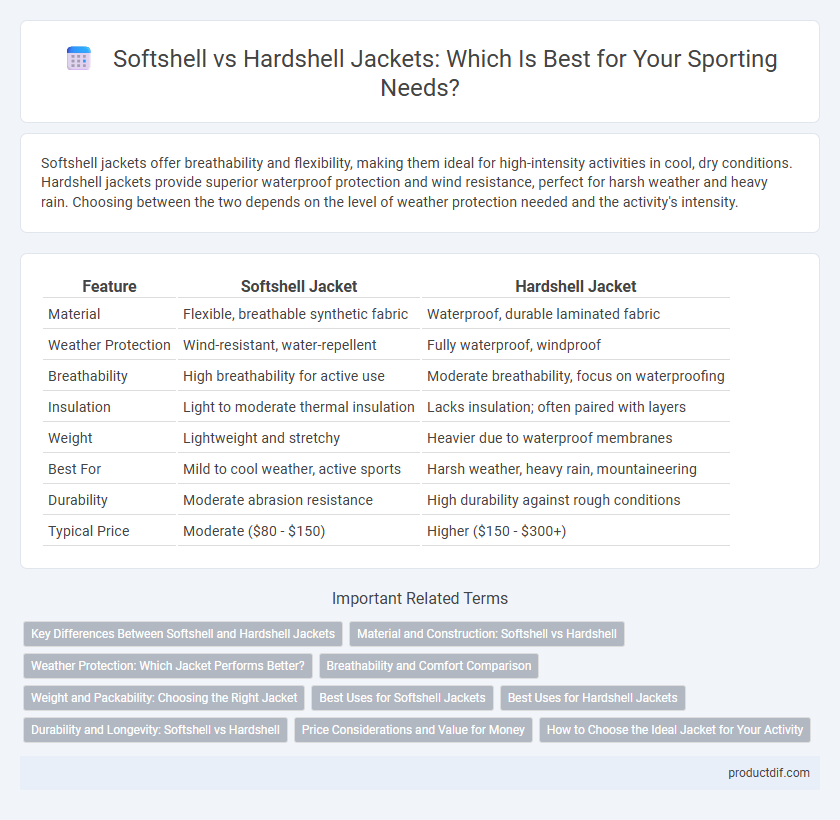Softshell jackets offer breathability and flexibility, making them ideal for high-intensity activities in cool, dry conditions. Hardshell jackets provide superior waterproof protection and wind resistance, perfect for harsh weather and heavy rain. Choosing between the two depends on the level of weather protection needed and the activity's intensity.
Table of Comparison
| Feature | Softshell Jacket | Hardshell Jacket |
|---|---|---|
| Material | Flexible, breathable synthetic fabric | Waterproof, durable laminated fabric |
| Weather Protection | Wind-resistant, water-repellent | Fully waterproof, windproof |
| Breathability | High breathability for active use | Moderate breathability, focus on waterproofing |
| Insulation | Light to moderate thermal insulation | Lacks insulation; often paired with layers |
| Weight | Lightweight and stretchy | Heavier due to waterproof membranes |
| Best For | Mild to cool weather, active sports | Harsh weather, heavy rain, mountaineering |
| Durability | Moderate abrasion resistance | High durability against rough conditions |
| Typical Price | Moderate ($80 - $150) | Higher ($150 - $300+) |
Key Differences Between Softshell and Hardshell Jackets
Softshell jackets prioritize breathability and flexibility, making them ideal for high-intensity outdoor activities in mild weather, while hardshell jackets offer superior waterproof and windproof protection, suited for harsh and wet conditions. Softshell fabrics typically feature a water-resistant finish and stretchy materials, whereas hardshells incorporate durable laminates like Gore-Tex to ensure impermeability against rain and snow. The choice between softshell and hardshell jackets depends on the balance of weather resistance versus comfort and mobility required for specific sporting activities.
Material and Construction: Softshell vs Hardshell
Softshell jackets feature a woven fabric blend like polyester and spandex that offers breathability, stretch, and moderate water resistance, designed for active use in variable conditions. Hardshell jackets utilize laminated waterproof-breathable membranes such as Gore-Tex combined with robust outer fabrics like nylon, providing superior protection against heavy rain and wind. The construction of softshells emphasizes flexibility and ventilation with bonded seams, while hardshells prioritize sealed seams and durable water repellent (DWR) coatings to maintain a fully waterproof barrier.
Weather Protection: Which Jacket Performs Better?
Softshell jackets offer excellent breathability and flexibility, making them ideal for mild to moderate weather conditions with light rain or wind. Hardshell jackets deliver superior weather protection through fully waterproof and windproof materials, designed specifically for heavy rain, snow, and harsh weather environments. When prioritizing maximum protection against severe weather, hardshell jackets outperform softshell jackets in keeping athletes dry and shielded.
Breathability and Comfort Comparison
Softshell jackets excel in breathability and comfort due to their flexible, lightweight fabric designed for active use, making them ideal for high-intensity outdoor activities and mild weather conditions. Hardshell jackets provide superior protection against wind and rain with waterproof, breathable membranes but may sacrifice some comfort and breathability compared to softshells. Choosing between them depends on the balance needed between weather protection and ventilation during sporting activities.
Weight and Packability: Choosing the Right Jacket
Softshell jackets are lightweight and highly packable, making them ideal for activities requiring flexibility and comfort, such as hiking or casual outdoor use. Hardshell jackets, while heavier and bulkier due to their waterproof membranes, provide superior protection against harsh weather conditions and are essential for severe rain or snow environments. Prioritizing weight and packability depends on the activity's intensity and weather, with softshells suited for breathable layers and hardshells for robust weather defense.
Best Uses for Softshell Jackets
Softshell jackets are ideal for activities requiring flexibility and breathability, such as hiking, climbing, and running in cool, dry conditions. Their lightweight, stretchy fabric provides excellent freedom of movement and moisture wicking, making them perfect for aerobic sports and layering in variable weather. Unlike hardshell jackets, softshells offer moderate water resistance but excel in comfort and ventilation during active outdoor pursuits.
Best Uses for Hardshell Jackets
Hardshell jackets excel in extreme weather conditions, providing superior waterproof and windproof protection essential for alpine climbing, skiing, and mountaineering. Their robust, durable materials withstand heavy rain, snow, and high winds, making them ideal for unpredictable outdoor environments. Engineered with breathable fabrics and often equipped with adjustable hoods and ventilation zippers, hardshells ensure comfort during intense physical activity in harsh climates.
Durability and Longevity: Softshell vs Hardshell
Hardshell jackets typically offer superior durability and longevity due to their robust, waterproof materials designed to withstand harsh weather conditions and abrasions. Softshell jackets, while flexible and breathable, generally have lower resistance to wear and tear, making them better suited for lighter outdoor activities. Choosing between softshell and hardshell jackets depends on the intensity of use and environmental exposure expected in sporting activities.
Price Considerations and Value for Money
Softshell jackets generally offer better value for money with a lower price point and sufficient protection for mild weather and active use, making them ideal for casual hikers or athletes. Hardshell jackets, costing significantly more, provide superior waterproofing and durability suited for extreme conditions, justifying the investment for serious outdoor enthusiasts. Choosing between the two depends on balancing budget constraints against the necessity for advanced weather resistance and long-term performance.
How to Choose the Ideal Jacket for Your Activity
Selecting the ideal jacket for outdoor activities depends on weather conditions and performance needs; softshell jackets offer breathability and flexibility, making them suitable for aerobic activities in mild to cool weather. Hardshell jackets provide superior waterproof and windproof protection, essential for harsh weather or stationary tasks in rainy or snowy environments. Prioritize factors like water resistance, breathability, mobility, and insulation to match the jacket to your specific sport or adventure conditions.
Softshell Jacket vs Hardshell Jacket Infographic

 productdif.com
productdif.com